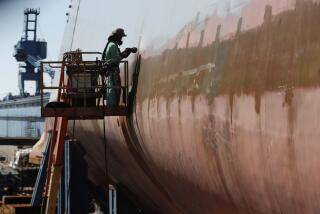We’re Being Shortchanged on New Army Vehicle
- Share via
The secretary of defense must put the controversy surrounding the Army’s $11-billion Bradley fighting vehicle program to rest. The Army must submit the troop carrier to realistic tests in a combat environment.
Doubts about the Bradley’s ability to deliver troops to the battlefield and fight with our front-line tanks surfaced as far back as a decade ago. A 1976 General Accounting Office report questioned the vehicle’s “battlefield effectiveness,” saying that the vehicle is too high, making it easier to see, the armor inferior, making it easier to destroy, and its diesel engine too noisy and smoky, giving away critical battlefield positions.
Today, 10 years and billions of dollars later, the same questions still avail; the Bradley’s vulnerabilities still haunt the Army. Worse yet, Army statements about the vehicle aren’t adding up. For example:
- The Army argues that the Bradley’s survivability is far superior to the troop carrier that it replaces. Evidence disputes this. Even in the Army’s own computer simulation, Soviet rocket-propelled grenades can debilitate and destroy the Bradley more often than its predecessor.
- The Army says that the Bradley’s speed and agility make it harder to find, track and destroy. But a recent Army simulation of a Bradley, versus its predecessor, dashing across open terrain typically found in Western Europe concludes otherwise. The Bradley showed a higher probability of being hit, slower acceleration and a frequent inability to cross terrain under both wet and dry conditions.
- The Army argues that teams equipped with Bradleys and modern tanks show superiority against opposing forces. However, this claim is not based on reliable field measurements. Through September, 1986, the Bradley has been used in limited training exercises at the Army’s national training center. Unfortunately, the training exercises were just that--exercises to train troops, not to measure the relative performance of Bradleys and tanks.
Even the recent Army-conducted vulnerability tests, which involve shooting ammunition at the vehicle, have caused controversy. The General Accounting Office reported that the Army avoided shots that could have directly penetrated the stowed ammunition in the vehicle.
Does this new evidence dispute the Army’s claims about the Bradley’s performance? Why are there still unanswered questions from a 10-year-old General Accounting Office report?
Let’s take the weapon out of the computer rooms and into the field for some realistic tests once and for all. Let’s answer crucial questions about the vehicle’s battlefield effectiveness and put an end to “Madison Avenue” sales pitches.
The Army has plans to complete combat testing on the Bradley by 1988--after nearly all 6,882 of the vehicles have been delivered. Logic would suggest that until these tests are completed the Bradley’s production should be put on hold. Further, Congress should demand independent test results from the Defense Department’s own, recently established, Office of Test and Evaluation.
A strong national defense mandates effective expenditure of every defense dollar. As Dwight D. Eisenhower, a man familiar with both war and politics, said, “This country could choke itself to death piling up military expenditures, just as surely as it can defeat itself by not spending enough for protection.”
Congress has already approved $6 billion for production of 4,300 Bradleys, and will be asked to approve close to $4 billion more over the next three years. The American people are being shortchanged. It’s time that questions are answered and rumors are put to rest.
More to Read
Sign up for Essential California
The most important California stories and recommendations in your inbox every morning.
You may occasionally receive promotional content from the Los Angeles Times.













